Table of Contents.
Train
Crash
In Saltsjöbaden, Sweden, 2013.
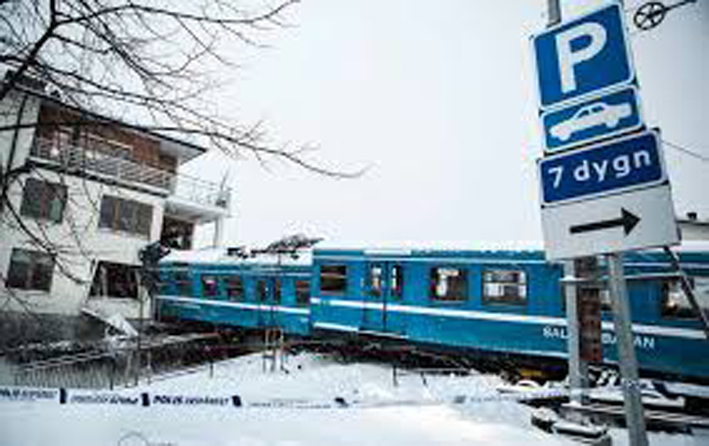
On January 15, 2013, at 2:25 a.m. a train drove
into a apartment building in Saltsjöbaden,
Stockholm. A person who was on the train was seriously injured but
survived. The
material damage to the building and the train became extensive.
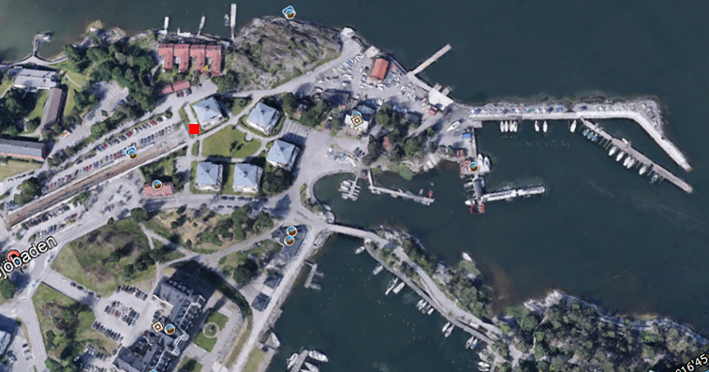
The train drove into the apartment building at the red square,
street address Saltsjögränd 10.
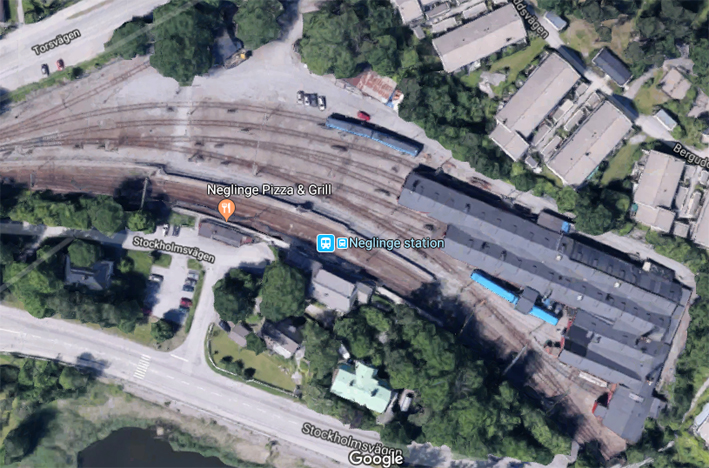
Neglinge station. The depot handled 30 trains at
night.
The train had been parked at the Neglinge station
earlier this night. The railway operator Arriva Sverige AB
has a depot which provides maintenance of the trains that are
in traffic at the railway section Saltsjöbanan. A
traffic management center is located in Neglinge. It was unmanned when
the crash occurred. The weather for the current night was snowfall
and -3° C. Under these conditions there was a risk of freezing of
the trains' brakes when the trains were parked
after the shift. To prevent freezing there was a system in use on
certain tracks in the depot area. You then connected a power cable (24
V) to the train set. This power supply, along with a driver's cab
procedure, enabled disconnecting the operating brake and the
emergency brake. The brakes had no abutment to the
wheels with this action and hence could not freeze. The system had a
built-in security. If the train was to be rolled, the power cable would
split and the power supply would be broken. The brakes were then
activated automatically.
In the railway yard a serviceman worked.
He was tasked with taking care of the trains that were handed over by
the drivers who had completed their shift. He
thought that the anti-freezing system would be used on the trains
received during the current night. On track 3 the system was
inoperative. He then resorted to a provisional solution to avoid
freezing to the brakes. He activated the cab and put the train in
operating mode.
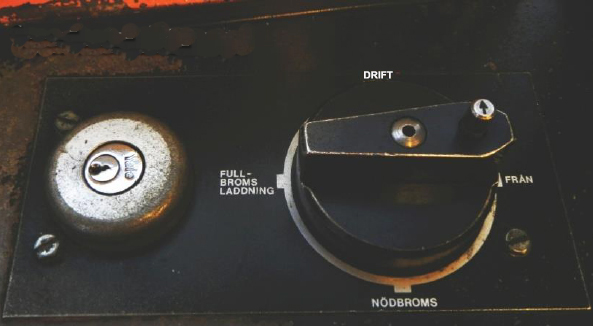
Lock and activation knob. After the crash, the
cab was investigated. The
activation knob then was in "operation" mode. A so-called control key
was
used to lock the knob. It was still in the lock
after the crash.
The driver's seat has a driver's control system with several
controls in the form of two foot pedals and a driving lever, of which at
least one must be held in a activated position to
let the brakes to be released and driving possible.
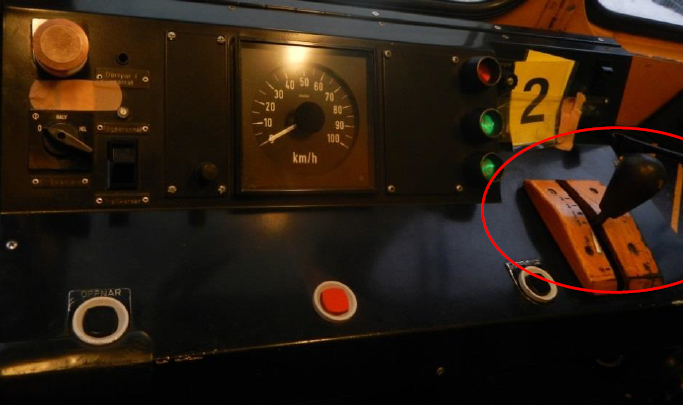
Control panel. To the right, (with a red ring
around it) the lever (also known as the safety
handle) is shown. The driving lever has four power modes: 0, 1, 2 and 3.
After the crash,
the lever was in position 3, ie. full power pace.
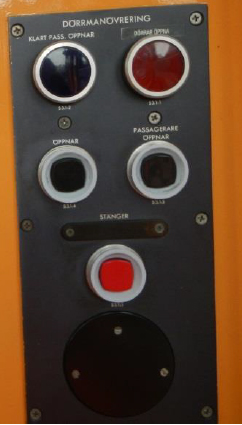
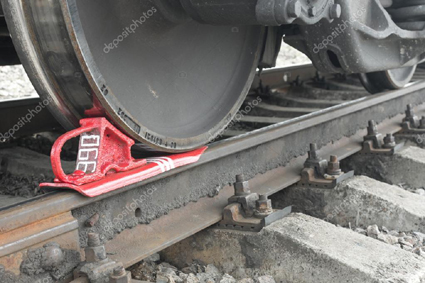
Control panel - doors.
No brake block was found in the cab after the crash.
The seviceman has stated that he:
1. Influenced the drive lever with a brake block. The brake block was
placed against the driving lever in such a way that a minor vibration or
similar would have caused the block to fall off and the brakes would
turn on.
2. Set the driving lever to full effect mode.
3. Folded the driver's seat to hold the brake block in place.
4. Set the doors to "passenger open" ("pass-open" mode)
My comment:
The arrangement was intended to prevent freezing of the brakes. Due to
the alleged activation of the driving lever, the brakes had no abutment
to the wheels. In the "pass-open" mode of the
passenger doors, you could not get a power boost with the driving lever. In this
situation, however, it was enough to close the
passenger doors to provide a power boost through
the driving lever. The arrangement was contrary to the railway operator's
regulations. In strict lawful terms, the serviceman
had committed a misconduct. However, he was never charged for
responsibility.
The Cleaning Lady
Sara, 22, worked as a Cleaning Lady
for the Caretia Cleaning
Company. This was the company that was responsible for
the cleaning of the carriages at the Neglinge
depot. Usually the
carriages
were cleaned at night time. Sarah
was hired in December 2012.

In her education to serve at the
Neglinge depot, she had a preview of some of the controls and functions
in the cab that are important for the cleaning work. She had been
instructed by Caretia's supervisor using a L-key to enter the cab and
the doors between the carriages,
and a T-key to open, close and control all
passenger doors. The cleaners had no access to the control key. The control
key is the key required to open the activation knob (see image above).
During this night she worked alone at the
depot. The colleague she usually worked with worked on Roslagsbanan
because there was a lack of staff there due to sick leave. During the
cleaning work, the servicemen could move the trains shorter stretches.
The cleaning work continued on these moves. She met the serviceman who
was responsible for the train at track 3. They spoke to each other
on a limited extent during the night. He did not
inform about the arrangement he had taken in the cab. The servicemen
usually facilitate the work of the cleaners by unlocking the doors
between the carriages. Then they usually call out that "pass-opening" is
on. The passenger doors can then be opened individually by the cleaner.
The gravel can be swept out through the doorway. When the cleaning work
was finished, Sara put out the floor mop on the staircase leading up to
the cab. The serviceman had previously entered the depot to carry out
some administrative work. As a last step in the
cleaning procedure, the Cleaning Lady
will check that the passenger doors would close
as they should. This is done via a control panel in the cab (see picture,
panel - door control above). When Sara checked the door closure, the
train started rolling.
Sara, who was badly injured in the
crash, has only weak memories of
it. She has stated that she tried to turn the
control key at the activation knob to stop the train set. It did not
help. It was also impossible to open the doors. She has given an
interview to the newspaper SEKO.
Here you can read it:
https://sekotidningen.se/nyhet/forstar-att-det-kommer-ga-at-helvete/
(all in Swedish).
The Crash.
When the serviceman returned to the railway yard, he discovered that the
train on track 3 was gone. He first thought that a train driver had
arrived early and launched the train. However,
this did not fit in time. He noted that the rail's
juncion was put in direction to the main track and not, as usual,
towards the depots maintenance premises. He also saw that the cleaner's
floor mop and bucket remained at track 3. He then
alerted his supervisor who went to Neglinge right away. The serviceman
called on the train over the radio but received no response. He then
realized that there was no one in the traffic management. Then he heard
police sirens and saw that the fire brigade was heading towards
Saltsjöbaden.
The crash site in Saltsjöbaden is located approximately 1700 m south of
the Neglinge station. The train set consisted of four carriages.
The train started rolling at 02:23:55 a.m..
It was put on the main track leading to Saltsjöbaden. The speed
increased gradually. When the train crashed at 02:25:35 a.m.
in Saltsjöbaden the speed was 80 km / h. The crash became violent. The
four carriages represented a considerable amount of motion energy. Where
the rail ended, there was a stopper mounted.
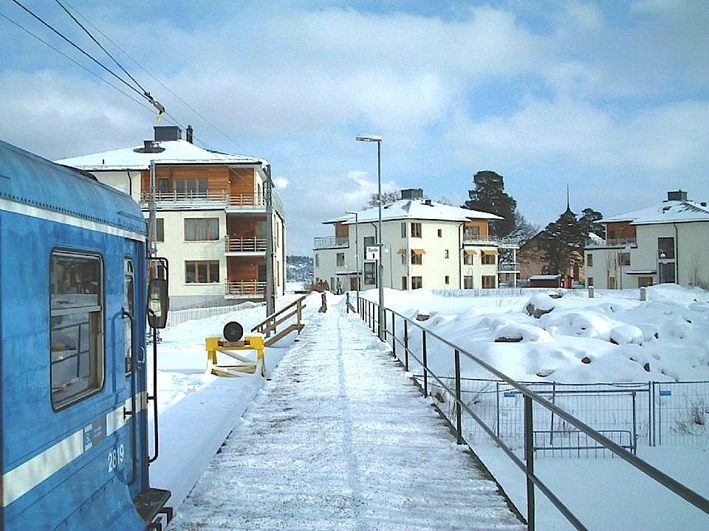
View of the crash site before the crash. The end
of the rail was at the yellow stopper. From that
point to the apartment building on the left the distance is about 30 m.
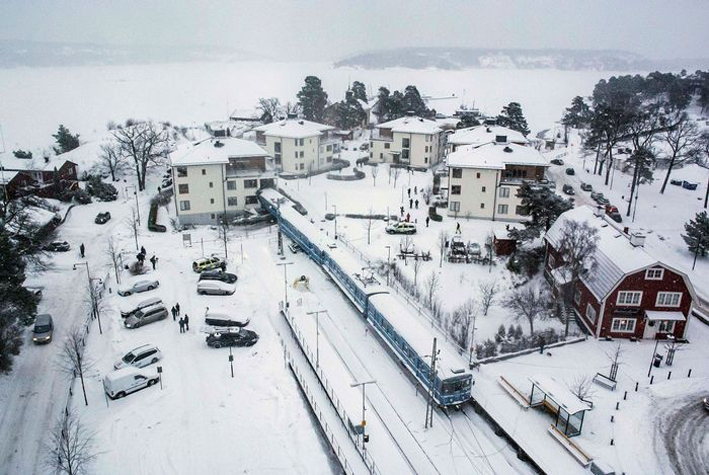
View of the crash site.
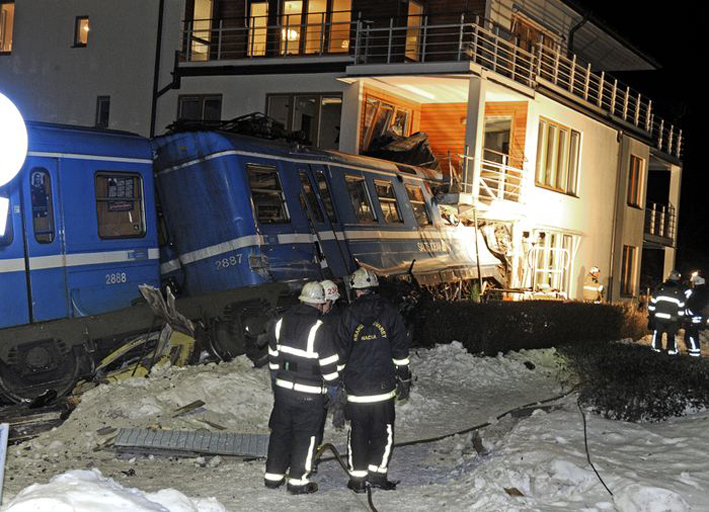
The train penetrated several meters into the
corner apartment that was at the ground floor.
The residents of the house were evacuated to a nearby hotel facility.
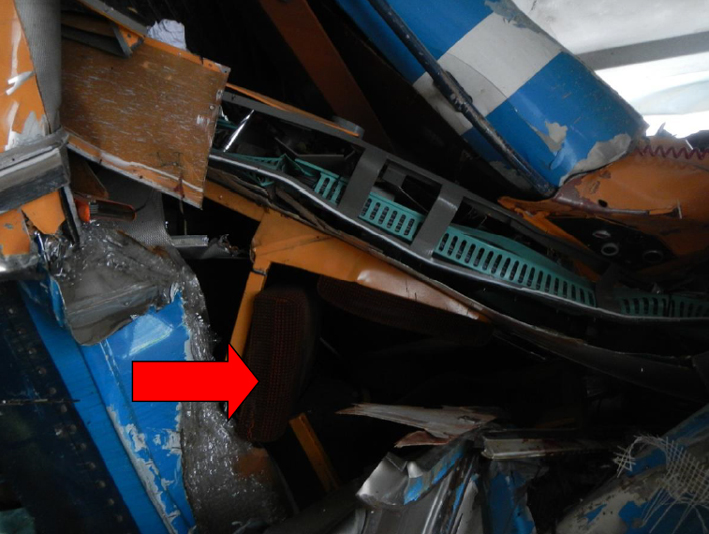
When the rescue team arrived, Sara was found in
the passenger compartment clamped to a
wall towards the cab. They had to cut her loose - an operation that took
about 3 hours.
Media.
The news of the "train accident" gained worldwide attention. Media
quickly featured the information that a Cleaning Lady had stolen a train
and then drove it into a residential building. On
January 16, 2013, Aftonbladet writes:
"A 22-year-old Cleaning Lady yesterday drove a train straight into a
residential building in Saltsjöbaden. The event became world news."
In the name of the truth, it should be mentioned that it was not only
Aftonbladet to uncritically swallow the Nazi lies. I have searched and
found a number of links on the Internet that relate to the event. In
most cases, the news papers have deleted their articles. Well, you
could consider this cleaning work as a
light in the darkness.
The Investigation Commission.
A Investigation Commission has submitted its report on the
5th
of May, 2014. The Commission's survey results are as follows:
a) The railway staff had the necessary qualifications.
b) No technical malfunction of the vehicle or track system has been
found.
c) Arriva Sverige AB had recently taken over operations on Saltsjöbanan.
d) The weather conditions at the time caused a risk of freezing of the
brakes.
e) The anti-freezing system at track 3 at the depot in Neglinge was out
of order. Some routines or supervisory directives dealing with how this
situation would be handled were not available.
f) An alternative way of loosening the brakes was used. It did not
follow operational routines and had not been anchored within the
management.
g) The train, with its
loose brakes, was left unattended with the contol
key left in the driver's cab.
h) It is technically possible to arrange relevant controls so that the
current vehicle type is brought into motion only by centrally closing
the doors from the cab.
i) Central door closure was a common occurrence when the cleaning was
finalized.
j) The train came in motion when the Cleaning Lady, who was alone on
board, was finishing the cleaning.
k) The rail's junction was put in such a way that
the vehicle's approach was taken out on the main track towards
Saltsjöbaden.
l) The brakes have not been activated before the collision with the
stopper in Saltsjöbaden.
m) The stopper did not prevent the vehicle's
approach from colliding with the apartment building.
n) The rescue effort was carried out in a qualified manner with the
removal of a person, taking in account the particular risks for the
collapse of the building.
o) It took over three hours before the Cleaning Lady could be removed
from the wreck.
Here you can download the Commission's
report: RJ2014_03.pdf
(2 MB, all in Swedish)
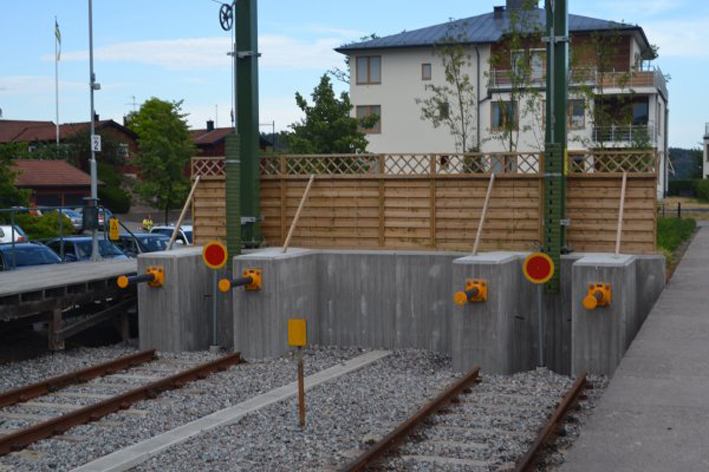
A safety barrier has replaced the stopper at
Saltsjögränd 10.
My comment:
The train crash in Saltsjöbaden was a
well-planned Nazi terrorist act. When I compare the approach, I conclude
that the same offenders are behind all the "accidents" way back to the
the 80's, and as I present in this blog. This also applies to an
international comparison because the terrorist network is
internationally branched.